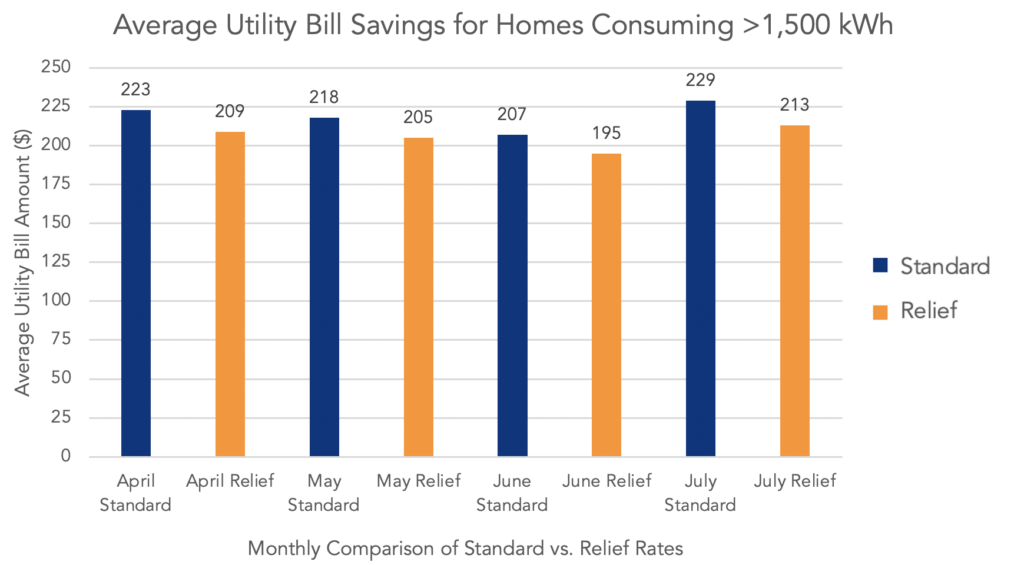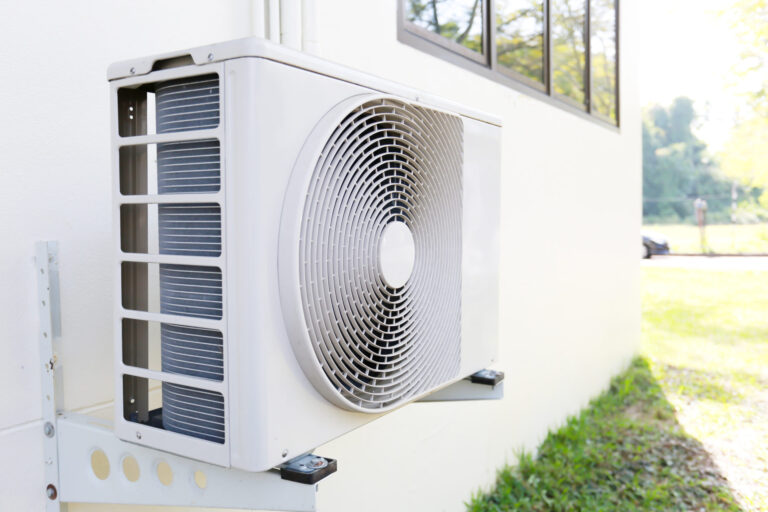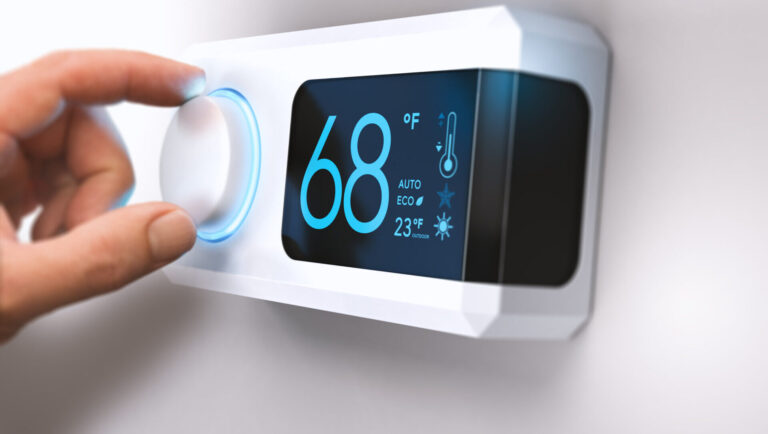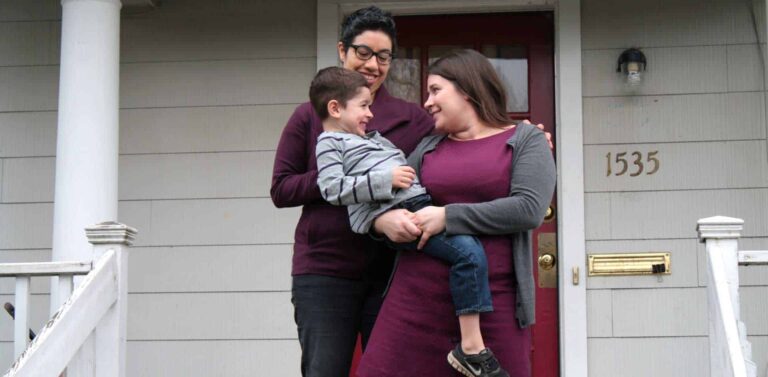August 28, 2020
 By Clayton Johnson, Communications Manager, Pecan Street
By Clayton Johnson, Communications Manager, Pecan Street
Increases in residential energy use during the pandemic exacerbate financial pressure, but utility programs have eased the burden
Only a few weeks into Austin’s shelter-in-place order, Pecan Street released an analysis of our home energy data showing an average 9% increase in utility bills for our research participants in March 2020 compared to bills from of March 2017-19.
Shortly after Austin’s shelter-in-place order took effect, the Austin City Council and Austin Energy rolled out a progressive utility bill relief package which, among other things, reduced the regulatory charge (from 1.252 cents/kWh to 0.85 cents/kWh) for all homes and capped rates at 7.814 cents/kWh for usage above 1,000 kWh/month. The rate cap effectively eliminated the two highest rate tiers and would result in bill savings for homes with usage over 1,500 kWh/month (the threshold for the next rate tier).
To show the impact of the relief package, we compared utility bills at the reduced rates to the standard, pre-COVID rate. Energy use in 2020 increased by 14% in April, 10% in May, 2% in June, and 4% in July compared to monthly averages from 2017-2019. It’s important to note that this increased energy use also includes a dramatic drop in electric vehicle charging over the same time period (read our blog on this topic here). Nearly 43% of the homes in our sample use level II EV charging at home, so the decrease in charging demand is likely masking the increases in energy use from other sources in the home, like HVAC, lighting, and appliances.
(See our blog on why the rate of electricity use increase leveled out as the weather got hotter in Austin. Spoiler: when it’s 110 degrees outside, HVAC’s are already running at near full capacity so there was little room to increase use.)
The regulatory charge was reduced by 32%, which on average saved residents in our sample a low of $2.84 in April to a high of $5.76 in July. According to Austin Energy, this should be a savings of roughly 4% of the total utility bill. However, the largest bill savings accrued from the rate cap for usage above 1,500 kWh, especially as temperatures and HVAC usage rose precipitously in June and July. In April, 15% of homes received this reduced rate. In May and June, this number rose to 46% and then 61%, respectively. And in July, 75% of households were paying reduced rates for their usage. For the homes that were able to benefit from reduced rates, the average savings ranged from $12-$16 per month for April through July.
What Does This Mean for Low-Income Households?
It’s important to note that the homes in our sample don’t necessarily represent the average Austin or American home. All of the homes in our analysis are located in Austin’s Mueller community, a modern mixed-use development, are less than 15 years old, and are priced above the area’s median value. However, we can speculate how increased energy use in these modern, well-insulated homes would translate to older homes and apartments, and such increased energy use (and cost) would be more consequential for lower-income customers. That’s why Austin Energy’s relief package also aims to assist homes with high energy burdens through a moratorium on disconnects, increased availability of payment arrangements, and expanded support through the Customer Assistance Program (CAP) and Financial Support Plus 1 Program. All of these were enacted in addition to the reduced regulatory charge and the cap on rates for higher rate tiers that all customers can access. You can find more information about Austin Energy’s relief package on their website here.
Supplemental LIHEAP Brings $94 Million in New Relief Dollars to Texas
Some much-needed good news for those struggling to pay their energy bills came with the passing of the Coronavirus Aid, Relief and Economic Security (CARES) Act, which will provide utility bill assistance for low-income households. The CARES Act authorized the Low Income Home Energy Assistance Program (LIHEAP) to provide $94 million in utility bill relief in Texas. Community Action Agencies across the state will administer these programs for eligible households, defined as earning no more than 150% of the Federal Poverty Level ($39,300/year for a family of four). Those interested in learning more about these relief programs can find the contact information for their local Community Action Agency here.
What’s Next for Utility Bill Relief Programs?
Utility bill relief programs protect customers from disconnects, allow customers to enroll in deferred payment plans, and offer financial assistance for utility bills. The Texas Energy Poverty Research Institute (TEPRI) recently reported that over half a million Texas households have been enrolled in Retail Electric Provider (REP) relief programs and over 130,000 have already received assistance.
Austin Energy plans to keep its relief package in place at least through September 30, 2020. And as reported by TEPRI, the Texas Public Utilities Commission (PUC) initially voted to extend assistance programs for REPs through the end of August, but later approved closing assistance program enrollments on August 31 and ending program benefits on September 30, 2020 (with the exception of deferred payment plans which are not set to expire at this time).
Texas utilities have played a critical role in relieving some of the financial burdens on customers during the pandemic and economic crisis. But their relief programs are just as critical today as they were during the previous five months. They have been a lifeline for those with lost wages and have helped make it possible for people to do their part to stay home and stop the spread of the virus. The Texas PUC, utilities, and city councils should continue their efforts to provide this much-needed support until COVID-19 infection rates have fallen to a level that allows Texans to safely return to work and school.
Read our first blog on this topic from April 17 below.
![]()
April 17, 2020
The overall decline in energy demand due to COVID-19 shelter in place (SIP) orders has been widely reported in recent weeks. However, Pecan Street’s recent analysis shows that in contrast with the overall trend in declining energy demand, residential demand is up. Of course, this comes as no surprise, given the amount of time we’re all spending at home. But what are the cost implications for this increase, especially with warmer weather just around the corner?
Pecan Street’s database of home energy use allows us to answer some of these questions. With this unique dataset, we’ve set out to understand exactly how residential energy use is changing under shelter in place, how this will affect homeowner’s utility bills, and the potential grid impacts as temperatures continue to rise in the coming weeks.
Shifting energy use is already hitting wallets
We compared energy use data from 103 homes in our research network from March 2020 to the average usage from March 2017, 2018 and 2019. All of the homes examined are located in Austin, TX. This analysis allowed us to calculate the expected change in the utility bills for individual homes in our sample. For March 2020 we saw an 11.5% increase in overall energy use compared to the average from March 2017-19. This would result in a 9.3% increase in utility bills. However, from March 24 -28 (after shelter in place was put in effect), we saw a steep increase in energy use, with the average home using 32.7% more electricity than in previous years. And it’s reasonable to assume this higher demand will continue throughout shelter in place.
The nonlinear correlation between increased energy use and increased utility bills is due to Austin Energy’s tiered energy rates, which progressively increase the amount a customer is charged based on the amount of energy they use. In other words, a 20% increase in energy use could translate to significantly more than a 20% increase in a customer’s bill (if the increased usage is billed in a higher rate tier). These higher costs are likely to be exacerbated if Austin’s shelter in place is still in effect as temperatures and energy usage rise as we move into summer.
It’s important to note that the 103 homes we examined are located in Austin’s Mueller community, a modern mixed use development where all of the homes are less than 15 years old, and most of them are priced above the area’s median value. The trend we see with these homes would place an even greater burden on low to moderate income households, which typically contribute a much higher percentage of their monthly budgets to energy costs.
Weather’s Impact: As temperatures rise, so will utility bills
Weather is likely to be the factor with the greatest impact on energy demand and utility bills under shelter in place. Overall, Austin’s shelter in place order has coincided with relatively mild weather; however, our recent analysis shows a significant increase in energy use, and HVAC use specifically, even when accounting for variations in weather (based on cooling degree days). See our previous blog post for a more detailed discussion of this analysis.
To reiterate, this increase occurred during relatively mild temperatures. In contrast, Austinites know well what temperatures are in store for the coming months, and if shelter in place is still in effect and energy use behaviors remain the same, residential energy usage and utility bills could reach historic levels. The convergence of these factors is likely to disproportionately impact low to moderate income households, which tend to have less efficient homes and appliances, and a higher energy burden than the average home.
Utilities Step Up Assistance
In an effort to mitigate these concerns, many utilities, including Austin Energy, have announced measures to limit these financial impacts on homes and businesses. The Austin City Council approved a utility bill relief package that included a moratorium on disconnects, increased availability of payment arrangements, reduced regulatory charge, a cap on rates for higher tiers (over 1,000 kWh/month), and expanded support through the Customer Assistance Program (CAP) and Financial Support Plus 1 Program. To learn more about eligibility and how to take advantage of these programs, visit Austin Energy’s COVID-19 Emergency Response webpage here: https://austinenergy.com/ae/about/news/coa-bill-relief
What’s Next?
In the coming weeks we will be analyzing energy use and cost data for a full billing cycle under shelter in place in order to gain a better understanding of the full range of impacts. We also plan to work with other community partners, like the Texas Energy Poverty Research Institute (TEPRI) to take a deeper dive into the implications for low to moderate income households that already have an oversized energy cost burden. Check back soon for more updates!
Methodology Details
- We examined a subset of our participants that have been part of our network for several years.
- Our calculations include a total of 103 homes.
- In each of these homes, our sensor equipment measures demand as frequently as every second.
- All homes are located in one neighborhood in Austin, Texas.
- We examined the total demand for the month of March for each home. For historic comparison, we averaged the same figures from previous Marches (2017, 2018 and 2019).
- Note: Billing cycles may not align with month start/end dates.
Details about March 2020 in Austin Texas
- All of the homes included in these analyses are part of Pecan Street’s research network and are located in Austin, Texas.
- Austin experienced one of the country’s first high-profile COVID-related cancelations when SXSW was called off on March 6.
- Spring Break for many Central Texas school districts was March 16-20. Austin Independent School District canceled all classes on March 12, the last day before Spring Break, and has closed all school buildings and facilities until May.
- Austin’s shelter in place order was put into place on March 24th.
- March weather in Austin is extremely varied. March 2020 included dramatic swings of cool (60s) and warm (low 90s) high temperatures the entire month.


















